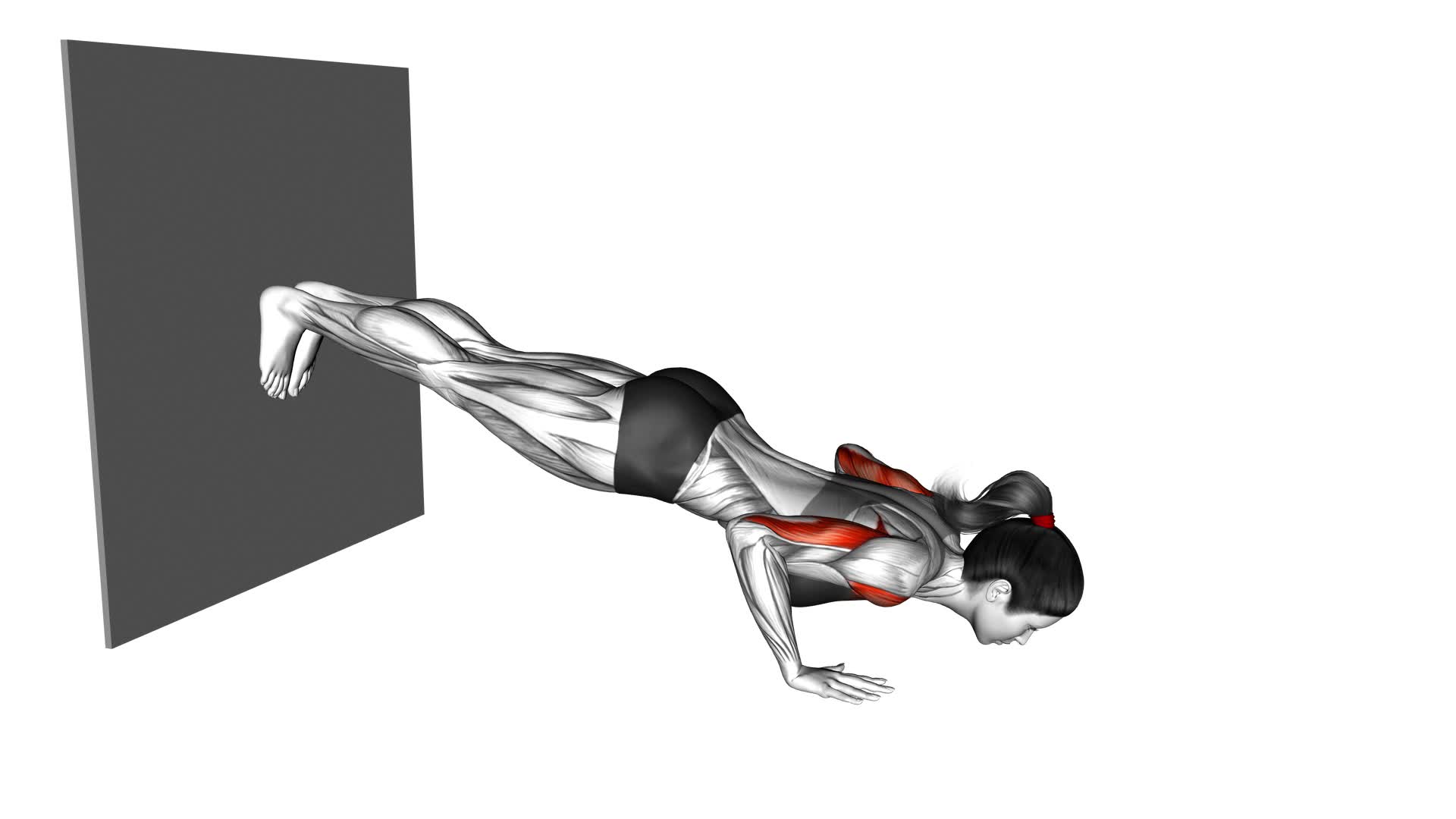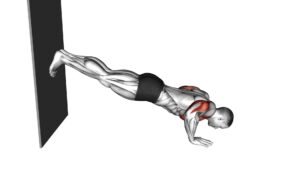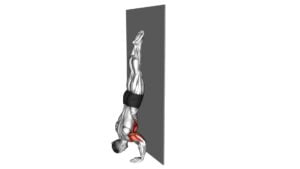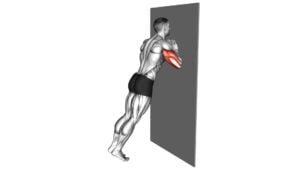Decline Push-Up Against Wall (Female) – Video Exercise Guide & Tips

Are you a female looking to strengthen and tone your upper body? Look no further than the decline push-up against the wall!
Watch This Exercise Video
This exercise is a great way to target your chest, shoulders, and triceps. In this article, we'll show you the proper form and technique, modifications for different fitness levels, common mistakes to avoid, and tips for maximizing your results.
Get ready to feel strong and confident with this effective workout. Let's dive in!
Key Takeaways
- Decline push-up against the wall is a beneficial exercise for increasing upper body strength.
- It targets the chest, shoulders, and triceps muscles while engaging the core for stability.
- The exercise improves overall muscular endurance and enhances push-up form and technique.
- Modifications can be made based on fitness levels and equipment availability to challenge oneself and progress over time.
Benefits of Decline Push-Up Against Wall
The decline push-up against the wall offers numerous benefits for women who want to strengthen their upper body muscles. This exercise primarily targets the chest, shoulders, and triceps, helping to tone and strengthen these muscle groups. By performing the decline push-up against the wall, you can effectively engage these muscles without the need for any equipment.
Additionally, the decline push-up against the wall can be modified to provide a full body workout. For example, you can incorporate leg raises or knee tucks to engage your core muscles while performing the exercise. This variation adds an extra challenge and helps to improve overall strength and stability.
Incorporating variations of the decline push-up against the wall into your workout routine can provide a comprehensive upper body and core workout for women. By targeting multiple muscle groups simultaneously, you can maximize your time and effort in the gym.
Now that you understand the benefits of the decline push-up against the wall, let's move on to the next section which will guide you on the proper form and technique for females. Mastering these key elements will ensure you get the most out of this exercise and minimize the risk of injury.
Proper Form and Technique for Females
To perform the decline push-up against the wall with proper form and technique, focus on maintaining a strong and stable core while engaging the chest, shoulders, and triceps. This exercise is a great addition to any female fitness routine, as it targets multiple muscle groups and helps build strength in the upper body.
Begin by standing facing a wall, about arm's length away. Place your hands on the wall slightly wider than shoulder-width apart, and step your feet back until your body forms a straight line from head to heels. Make sure to keep your core engaged throughout the movement.
Next, lower your body towards the wall by bending your elbows and keeping them close to your sides. Aim to bring your chest as close to the wall as possible, while maintaining proper form. Then, push through your palms to extend your arms and return to the starting position.
Remember to breathe consistently throughout the exercise and avoid locking your elbows at the top. Focus on controlled movements and maintain proper alignment of your body.
Incorporating the decline push-up against the wall into your strength training routine can help improve upper body strength and overall fitness. Keep practicing and gradually increase the number of repetitions to continue challenging yourself and achieving your fitness goals.
Modifications for Different Fitness Levels
For different fitness levels, there are various modifications you can make to the decline push-up against the wall exercise. Whether you're a beginner looking to build strength or an advanced fitness enthusiast seeking a challenge, these modifications can help you tailor the exercise to your specific needs.
Here are some options to consider:
- Beginner Modifications:
- Start with a higher incline by placing your hands on a higher surface, such as a bench or step, to reduce the intensity.
- Perform the exercise on your knees instead of your toes to decrease the amount of body weight you're lifting.
- Use a stability ball against the wall to provide added support and stability.
- Advanced Modifications:
- Elevate your feet on a higher surface, such as a sturdy chair or step, to increase the difficulty and engage more upper body muscles.
- Introduce instability by using a BOSU ball against the wall, which challenges your core muscles and improves balance.
By incorporating these modifications into your decline push-up against the wall exercise, you can effectively progress or regress the intensity to suit your fitness level.
Remember to always listen to your body and choose the modification that allows you to perform the exercise with proper form and without pain.
Common Mistakes to Avoid
To ensure proper form and maximize the effectiveness of your decline push-up against the wall exercise, it's important to be aware of common mistakes to avoid.
One common mistake is allowing your elbows to flare out to the sides during the movement. This puts unnecessary strain on your shoulder joints and reduces the engagement of your chest muscles. Instead, keep your elbows tucked close to your body, forming a 45-degree angle with your torso.
Another mistake to avoid is sagging your hips or arching your back. This not only compromises the effectiveness of the exercise but also puts strain on your lower back. To maintain proper form, engage your core muscles and keep your body in a straight line from your head to your heels.
Lastly, rushing through the exercise is a common mistake that can lead to sloppy form and decreased benefits. Take your time and focus on the quality of each rep. Lower yourself down slowly and push back up with control, ensuring that you maintain proper alignment throughout the entire movement.
By avoiding these common mistakes and maintaining proper form, you'll be able to maximize the effectiveness of your decline push-up against the wall exercise.
Now, let's move on to the next section where we'll provide you with tips for maximizing your results.
Tips for Maximizing Results
To maximize your results, consistently focus on maintaining proper form and technique during your decline push-up against the wall exercise. Here are some tips to help you get the most out of your workout:
- Maintain a straight body alignment: Keep your core engaged and your back straight throughout the exercise. This will ensure that you're targeting the right muscles and avoiding unnecessary strain.
- Control your descent: Slowly lower yourself down towards the wall, maintaining control and resisting the urge to drop quickly. This will increase the intensity of the exercise and engage your muscles more effectively.
- Breathe properly: Inhale as you lower yourself down and exhale as you push yourself away from the wall. Proper breathing technique helps to oxygenate your muscles and maintain stability throughout the movement.
- Focus on quality over quantity: It's better to perform a few repetitions with proper form than to rush through a large number of sloppy push-ups. Pay attention to your body and ensure that each repetition is performed correctly.
- Support your workouts with proper nutrition: Eating a balanced diet that includes lean proteins, healthy fats, and complex carbohydrates will provide your body with the nutrients it needs to build and repair muscle. Stay hydrated and fuel your workouts for optimal results.
For this exercise, you don't need any specific equipment. Just find a sturdy wall and make sure you have enough space to perform the push-ups comfortably.
Frequently Asked Questions
How Many Calories Can You Burn by Doing Decline Push-Ups Against a Wall?
You can burn a significant number of calories by doing decline push-ups against a wall. The exact amount will depend on factors such as your weight and intensity of the exercise. However, it's estimated that you can burn around 7-10 calories per minute by performing decline push-ups.
To modify this exercise, you can start with an easier variation, such as incline push-ups against a wall, and gradually progress to decline push-ups as you build strength.
Can I Do Decline Push-Ups Against a Wall if I Have Lower Back Pain?
If you're experiencing lower back pain, it's important to be cautious when doing exercises like decline push-ups against a wall. These exercises can put strain on your lower back, potentially exacerbating your pain.
It's best to consult with a healthcare professional or a certified trainer who can provide modifications or alternative exercises that will target your upper body without putting unnecessary stress on your lower back.
Safety should always be a priority when it comes to your fitness routine.
How Often Should I Incorporate Decline Push-Ups Against a Wall Into My Workout Routine?
To determine how often you should incorporate decline push-ups against a wall into your workout routine, consider your fitness goals and current fitness level.
Start by doing them 2-3 times a week and gradually increase the frequency as you get stronger.
It's also important to vary your workouts by incorporating different push-up variations and progressions. This will challenge your muscles and prevent boredom.
Remember to listen to your body and rest when needed to avoid overtraining.
Can Decline Push-Ups Against a Wall Help in Reducing Arm Fat?
Decline push-ups against a wall are a great way to tone your arms. By targeting the muscles in your arms, these exercises can help reduce arm fat and increase muscle definition.
The benefits of decline push-ups include building strength in your chest, shoulders, and triceps. Incorporating these arm toning exercises into your workout routine can lead to noticeable improvements in your upper body strength and overall physique.
Are Decline Push-Ups Against a Wall Suitable for Beginners?
Decline push-ups against a wall are effective for building upper body strength and can be modified for different fitness levels. They're suitable for beginners as they provide a challenging workout while reducing the strain on the wrists and shoulders compared to traditional push-ups.
Conclusion
In conclusion, the decline push-up against the wall is a beneficial exercise for females, as it helps to strengthen the upper body and core muscles.
By maintaining proper form and technique, and making modifications based on individual fitness levels, one can maximize the results of this exercise.
It's important to avoid common mistakes and follow the provided tips for best outcomes.
Incorporating this exercise into your fitness routine can lead to improved strength and overall fitness.

Author
Years ago, the spark of my life’s passion ignited in my mind the moment I stepped into the local gym for the first time. The inaugural bead of perspiration, the initial endeavor, the very first surge of endorphins, and a sense of pride that washed over me post-workout marked the beginning of my deep-seated interest in strength sports, fitness, and sports nutrition. This very curiosity blossomed rapidly into a profound fascination, propelling me to earn a Master’s degree in Physical Education from the Academy of Physical Education in Krakow, followed by a Sports Manager diploma from the Jagiellonian University. My journey of growth led me to gain more specialized qualifications, such as being a certified personal trainer with a focus on sports dietetics, a lifeguard, and an instructor for wellness and corrective gymnastics. Theoretical knowledge paired seamlessly with practical experience, reinforcing my belief that the transformation of individuals under my guidance was also a reflection of my personal growth. This belief holds true even today. Each day, I strive to push the boundaries and explore new realms. These realms gently elevate me to greater heights. The unique combination of passion for my field and the continuous quest for growth fuels my drive to break new ground.







